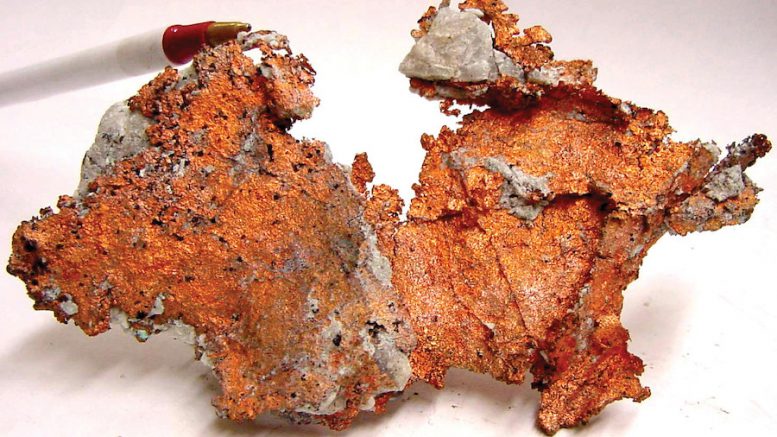Advances in technology to increase metal recovery could save billions of dollars and wipe out the 20% gap between copper supplies and demand as green energy accelerates, according to a new report by McKinsey & Co.
Electrification is expected to increase global annual copper demand to 36.6 million tonnes by 2031 while current mines, probable projects and recycling may supply 30.1 million tonnes by then, the McKinsey Metals & Mining Practice said in the report released late Friday.
Technologies such as coarse particle recovery, sulphide leaching and artificial intelligence (AI) to improve processes could recover up to 7.9 million tonnes of copper a year, erasing the 6.5-million-tonne-a-year deficit, according to the report.
“The obstacles to commercialization and widespread adoption are not trivial,” McKinsey said. “But technological levers should be recognized alongside new mine development as part of the solution.”
If applied across the industry beyond just copper, McKinsey estimates the methods could save more than US$100 billion a year.
That could help reach the US$100 billion that London-based analyst CRU Group said the industry needs to spend on new copper production to meet demand by the end of the decade. Although the price of copper has risen by 25% over the last five years, according to mining.com, decades-high inflation and interest rates are hampering some developments.
McKinsey’s supply gap estimate is a bit less than the 8 million tonne shortfall by 2032 forecast last year by Chile’s state run Codelco, the world’s largest copper producer. Other top miners of the metal used in wiring and plumbing, such as BHP (ASX: BHP), Freeport-McMoran (NYSE: FCX) and First Quantum Minerals (TSX: FM) all have projects in the works.
Grind-circuit roughing
McKinsey suggests a couple of technologies to try to recover particles outside a sweet spot of extraction between 50 and 150 microns (a micron is a thousandth of a millimetre). One way is to use grind-circuit roughing, which operates like a sponge on the particles and can increase the throughput of a ball mill by 20%.
That process, which McKinsey said is offered by Connecticut-based Cidra Holdings, could add 1.2-4.6 million tonnes of global annual copper production by 2032, as well as cut energy use. If the system is applied to all metals produced from sulphide ores, the cost savings could run US$20-US$80 billion a year worldwide, McKinsey said.
The other method to improve coarse particle recovery, scavenging, focuses on the flotation process. While some heavier particles might sink from the froth in a tank which is skimmed off in recovery, scavenging adds layers to keep them afloat.
The process, offered by Pennsylvania-based Eriez Flotation, could increase recovery by 2-6%, adding up to 1.5 million tonnes of global annual copper production. If likewise applied to all metals produced from sulphide ores, McKinsey figures it could save US$9-US$26 billion a year.
Sulphide leaching is being improved along several lines, including chloride-based solutions, to process ore lower than 0.25% copper that is often discarded as tailings. Rio Tinto’s (NYSE, ASX, LSE: RIO) environmental and low capital cost Nuton bio-leaching process is also being used by McEwen Mining (TSX: MUX; NYSE: MUX) and Arizona Sonoran Copper (TSX: ASCU; US-OTCQX: ASCUF). Jetti Resources, a service provider in Colorado, offers a catalyst-based system for leaching primary sulphide ore.
It’s a low-capital approach to a problem currently solved using expensive concentrators, McKinsey said. However, there are barriers to widespread commercialization of new sulphide leaching methods such as limits to installing them on existing heap leach pads instead of applying them to tailings.
Water savings
Overcoming the barriers by the end of decade would add 2.4 million tonnes of copper a year by 2032. It would also cut water usage, tailings risk and US$45 billion a year in costs for all sulphide-borne metal, McKinsey said.
AI machine learning can use speed and consistency to reduce human error in adjusting processing to meet the variability of an ore body. However, the best operations keep humans in control to see overall goals so the process doesn’t lose itself in algorithms, the consultant said.
This greater efficiency can add 2-4% to metal recoveries and 5-15% to throughput for an increase in global annual production from existing and planned mines of up to 1 million tonnes of refined copper by 2032. It would save US$9-US$18 billion a year across all sulphide concentrators, McKinsey said.
The increased savings and metal recoveries of coarse particle recovery, sulphide leaching and machine learning also show the importance of miners developing internal innovation groups, forming links with tech-savvy juniors and exploiting brownfield sites, according to the consultant.
“These technologies also offer new options for greenfield projects,” McKinsey said. “This approach can enable an incremental development model similar to that often used for gold deposits, particularly in high-risk areas, where the capital at risk and the payback period are critical investment criteria.”


Be the first to comment on "Three ways to harvest more copper and save billions"